I’m a huge fan of anthology movies. I love everything from Dead of Night to Scare Package, and one of my favorites is the Shudder gem The Mortuary Collection. It has arguably the best frame story I’ve ever seen, and the smaller stories within it aren’t too shabby, either.
On top of that, The Mortuary Collection also doubles down on one of my favorite elements of anthology films. Most of the stories in these movies are essentially just morality tales transposed into a horrific key, and this film absolutely revels in that fact. All of its individual segments convey clear moral messages, and the frame story hammers the point home in a really cool way.
It seamlessly integrates this theme into its intriguing mythology, so you never feel like you’re just being preached to. In fact, you can easily get so caught up in the horrific fun that you don’t even notice it, so let’s take a deep dive into The Mortuary Collection and see just how it emphasizes this venerable anthology tradition.
“The Universal Balance of All Things”
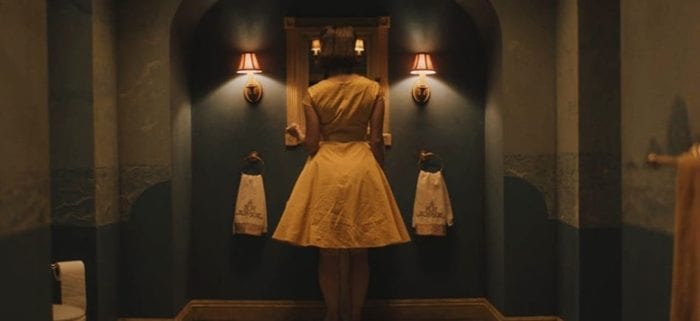
Let’s start with the first segment. It’s pretty short, but it plays an important role in the overall message of the film. It’s about a woman who pickpockets a bunch of men at a party, and when she goes to the bathroom to look at the wallets she’s stolen, she gets a big surprise. After taking the money out and disposing of the wallets, she becomes intrigued by the medicine cabinet. She seems to think there may be other goodies to steal in there, but she instead finds a large, tentacled monster that pulls her into the cabinet and kills her.
This story is short, sweet, and to the point, and it also packs a pretty obvious moral punch. In fact, when Sam, the young girl looking for a job at the mortuary, objects that it’s not all that realistic, the mortician Montgomery tells her that what matters isn’t “the validity of the story […] but the message within.”
And what is that message? Sam suggests that it’s “Don’t stick your nose where it doesn’t belong,” but Montgomery has something much bigger in mind. Yes, he acknowledges, that’s true “in a most basic sense,” but “on a deeper level,” it’s “about the universal balance of all things.”
I have to admit, the first time I saw The Mortuary Collection, that line took me by surprise. This story is only a few minutes long, and it only has one character, so I wasn’t sure how it could be about anything universal. I was initially with Sam on this one, but after thinking about it a bit more, I finally realized what Montgomery was getting at.
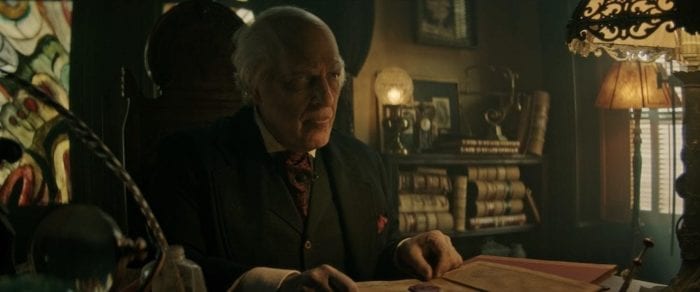
Sure, the woman in the story essentially gets killed for stealing, but the ultimate message here goes well beyond that one specific act. It exemplifies a larger, more universal principle: all evil must be punished. In other words, the world always maintains a balance, so when someone upsets that balance by committing evil, the universe has to punish that person and restore its equilibrium.
And with that, The Mortuary Collection sets the stage for everything else that is to come. It lets us know that all of Montgomery’s stories are going to be morality tales about bad people getting their comeuppance, and if you’re a fan of anthology films, that’s not surprising at all. Like I said before, that theme is a staple of the subgenre, but what sets this movie apart is that it explicitly lets us know what it’s doing.
With most anthologies, we have to figure out for ourselves what their ultimate message is, but this one just comes out and tells us right off the bat. It lets us know without a doubt that it’s going to continue this hallowed anthology tradition, but as we’ll soon find out, it still has a few unexpected twists and turns to keep us on our toes.
A Timeless Message
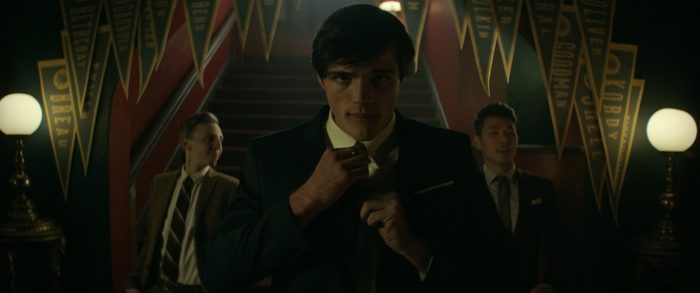
The next two stories in The Mortuary Collection are pretty straightforward. They both exemplify Montgomery’s “universal balance” in very obvious ways, so if you watch the film, you’ll have no trouble seeing how they fit into its overall message.
However, once the third segment is done and we get back to the frame story, things start to get a bit more interesting. Sam tells Montgomery, “All of your stories are a little predictable.” In every one of them, she says, “someone commits a sin, they pay a horrible price, rinse, repeat.” It’s the same thing every time, but she wants a bit of variety. In response, Montgomery explains that his stories are all so similar because “the message is timeless: no evil deed goes unpunished,” but Sam isn’t entirely convinced. She questions whether he really believes that, and he says that he does.
Every time I watch this conversation, I can almost imagine the characters turning to the camera and winking at the audience. They’re letting us know once again that The Mortuary Collection is proudly and unabashedly following in the footsteps of movies like Creepshow and From Beyond the Grave. It’s telling a bunch of morality tales that exemplify the “universal balance of all things,” and Montgomery in particular seems really committed to that message. Despite all of Sam’s skepticism and protests to the contrary, he firmly believes that this principle is true and that it’s worth repeating every time he tells another story.
“Real Life”
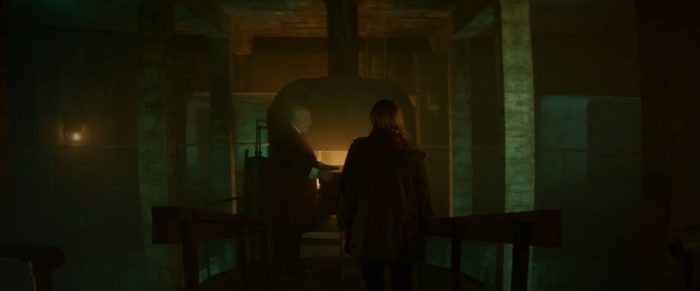
But after that, the film throws a curveball at us. Montgomery leads Sam down to the crematorium, and just as he’s about to cremate a body, Sam tells him to stop. She says that he’s wrong, that “in real life, bad guys win all the time,” and she has a story to prove it. She knows the person Montgomery is about to cremate, and she says his death was all her fault.
This then leads into the fourth story in The Mortuary Collection, and it’s about Sam and a young boy she was babysitting. At one point during the night, an escaped mental patient attacks her, and he wants to hurt the child. After a long struggle, Sam manages to kill him and save the kid’s life, but then the story does a complete 180. We learn that Sam is actually the escaped mental patient, and the man who attacked her was the real babysitter. Her name is actually Charlotte, and she’s a convicted murderer known as the Boggy Bay Tooth Fairy.
After that ordeal, she kills the boy herself, and when we return to the frame story, she reveals the real reason she went to the mortuary. She wasn’t actually looking for a job there. No, she just wanted to take one of the kid’s teeth for her collection, a tradition she apparently wasn’t able to carry out this time before his parents got home, so she takes out a knife and carries out her grisly custom. After that, she stabs Montgomery, and she explains that “in real life, the bad guy wins.”
At this point, it seems that The Mortuary Collection has pulled a fast one on us. We thought it was all about some sort of “universal balance” in which “no evil deed goes unpunished,” but it looks like we were wrong. Sam’s story and her murder of Montgomery disprove that silly notion, and if we’re honest with ourselves, we have to admit that we always knew she was right.
While it may feel good to believe that the universe (or God, or whatever higher power we believe in) always stands up for the cause of goodness and right, we know that’s not how life actually works. We know that bad guys get away with horrible crimes all the time, and there’s often nothing anybody can do about it.
So, it seems, the real message of The Mortuary Collection isn’t that bad people always get what’s coming to them. Instead, it appears to be the exact opposite. The point seems to be that life is nothing like the anthology stories this movie is cleverly subverting. The real world is cruel and unfair, so Montgomery’s optimism is entirely misplaced. Sure, sometimes the good guys do win, but the bad guys come out on top just as often.
One Last Twist

That’s a pretty depressing note to go out on, but don’t worry, the movie doesn’t end there. It still has one last curveball to throw our way, and it’s a big one. When Sam stabs Montgomery, he initially falls down like he’s dying, but after a few moments, he just laughs and stands back up like nothing ever happened. Sam becomes flabbergasted and runs away in terror, but no matter where she goes, the house won’t let her leave. She can’t seem to find her way out, and she eventually ends up in a library, where Montgomery gives one last speech that sums up the main theme of the film.
He says that he was once just like her, “unbounded by the laws of nature, or so I thought,” but that all changed when he arrived at the mortuary. He goes on to explain that storytellers “remind us that each and every action creates a ripple, each and every story has repercussions.” As he says all this, books start to fall from the shelves and open up. Montgomery explains that these books contain Sam’s stories, and then the vengeful souls of her victims rise up out of them and kill her. After that, she takes Montgomery’s place, and The Mortuary Collection ends with her becoming the new undead mortician.
There’s a lot to unpack here, but at the most basic level, this final twist confirms that the movie really is continuing the anthology tradition of telling a bunch of morality tales. In fact, the film doesn’t just contain morality tales. The whole thing simply is one big morality tale. As Montgomery tells his stories, he keeps harping on the idea that evil never goes unpunished, and when Sam thinks she’s proved him wrong, the tables immediately turn and show that he’s actually right. She too gets punished for all the evil she’s committed throughout her life, and in an almost poetically fitting way, that punishment comes at the hands of all the kids she’s murdered.
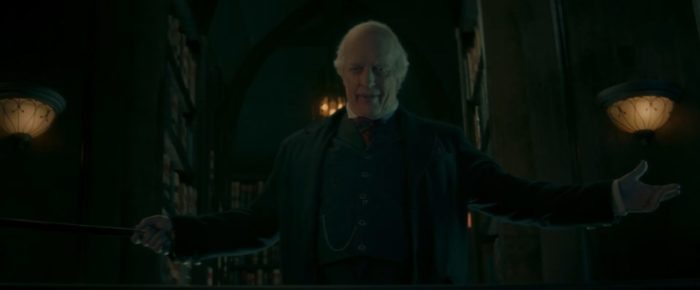
And if we dig a bit deeper, we’ll see that a lot of the details in Montgomery’s final speech contribute to this theme as well. For example, he says that he used to think he was “unbound by the laws of nature,” and when you first hear that line, it may seem a bit out of place. He’s been talking about morality the entire time, so how do the laws of nature fit into the picture?
From what he says next, it’s clear that he’s referring to the “universal balance” he mentioned earlier in the movie. He’s talking about the law that “every action creates a ripple” and that “each and every story has repercussions.” Apparently, in the world of The Mortuary Collection, that really is how things work, so unlike most anthology films, this one doesn’t just tell a bunch of stories where the bad guys simply happen to get punished. Rather, it tells those kinds of stories because that’s how nature operates, and stories are supposed to remind us of that.
Now, I think it’s fair to assume that the filmmakers behind The Mortuary Collection don’t actually believe any of this. I highly doubt that they believe in Montgomery’s “universal balance” or the idea that all stories are supposed to be morality tales. I’m sure they know that Sam is actually right and the bad guys really do win just as often as the good guys (if not more often!), so we’re almost certainly not supposed to take the film literally.
Instead, it’s just a fun celebration of the storied (pun totally intended) history of anthology films, and it’s an absolute blast. It takes arguably the best-known anthology trope and doubles down on it to an absurd extent, and then it uses that idea to create a brand new mythology that’s both intriguing and amusing. It’s a real treat for fans of this subgenre, so if you enjoy watching short stories where evil people get what’s coming to them, you’re sure to get a huge kick out of The Mortuary Collection.



